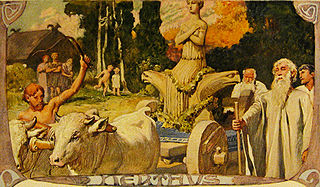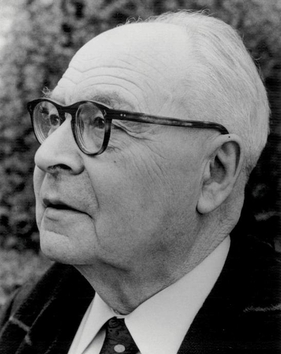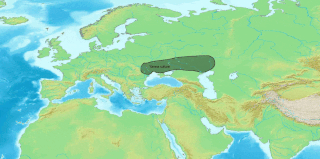Iranian mythology or Iranic mythology may refer to any of the following mythologies of various Iranian peoples:
Bel can mean:

Indra is the king of the devas and Svarga (heaven) in Hinduism. He is associated with the sky, lightning, weather, thunder, storms, rains, river flows, and war. Indra's powers are similar to other Indo-European deities such as Jupiter, Perun, Perkūnas, Zalmoxis, Taranis, Zeus, and Thor, part of the greater Proto-Indo-European mythology.

Germanic mythology consists of the body of myths native to the Germanic peoples, including Norse mythology, Anglo-Saxon mythology, and Continental Germanic mythology. It was a key element of Germanic paganism.

Georges Edmond Raoul Dumézil was a French philologist, linguist, and religious studies scholar who specialized in comparative linguistics and mythology. He was a professor at Istanbul University, École pratique des hautes études and the Collège de France, and a member of the Académie Française. Dumézil is well known for his formulation of the trifunctional hypothesis on Proto-Indo-European mythology and society. His research has had a major influence on the fields of comparative mythology and Indo-European studies.

Persian mythology or Iranian mythology is the body of the myths originally told by ancient Persians and other Iranian peoples, and a genre of Ancient Persian folklore. These stories concern the origin and nature of the world, the lives and activities of deities, heroes, and mythological creatures, and the origins and significance of the ancient Persians' own cult and ritual practices. Modern scholars study the myths to shed light on the religious and political institutions of not only modern-day Iran but the Greater Iran, which includes regions of West Asia, Central Asia, South Asia and Transcaucasia where Iranian culture has had significant influence. Historically, these were regions long ruled by dynasties of various Iranian empires, that incorporated considerable aspects of Persian culture through extensive contact with them, or where sufficient Iranian peoples settled to still maintain communities who patronize their respective cultures. It roughly corresponds to the Iranian plateau and its bordering plains. The Encyclopædia Iranica uses the term Iranian Cultural Continent for this region.
Iranian religions, also known as Persian religions, are, in the context of comparative religion, a grouping of religious movements that originated in the Iranian (Persian) plateau.
A supreme deity, supreme god or supreme being is the conception of the sole deity of monotheistic religions or, in polytheistic or henotheistic religions, the paramount deity or supernatural entity which is above all others.
Spirit of God may refer to:
Indian mythology may refer to:
The religions of the ancient Near East were mostly polytheistic, with some examples of monolatry. Some scholars believe that the similarities between these religions indicate that the religions are related, a belief known as patternism.

Armenian mythology originated in ancient Indo-European traditions, specifically Proto-Armenian, and gradually incorporated Hurro-Urartian, Mesopotamian, Iranian, and Greek beliefs and deities.
Ashur, Assur, or Asur may refer to:
Ira or IRA may refer to:
Middle East mythology includes:
Sacred cow(s) may refer to:
There are many references to ghosts in ancient Mesopotamian religion – the religions of Sumer, Babylon, Assyria and other early states in Mesopotamia. Traces of these beliefs survive in the later Abrahamic religions that came to dominate the region.
Pahal may refer to:

Ancient Iranian religion or Iranian paganism was the ancient beliefs and practices of the Iranian peoples before the rise of Zoroastrianism. The religion closest to it was Hinduism that is practiced in India. The major deities worshipped were Varuna and Mithra from Iran to Rome, but Agni was also worshipped, as names of kings and common public showing devotion to these three exist in most cases. But some sects, the precursors of the Magi, also worshipped Ahura Mazda, the chief of the Asuras. With the rise of Zoroaster and his new, reformatory religion; Ahura Mazda became the principle deity and the Devas were relegated to the background. A lot of the attributes and commandments of Varuna, called Fahrana in Median times, were later attributed to Ahura Mazda by Zoroaster.
This is an index to deities of the different religions, cultures and mythologies of the world, listed by region or culture.